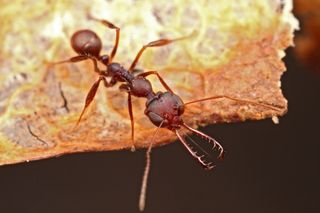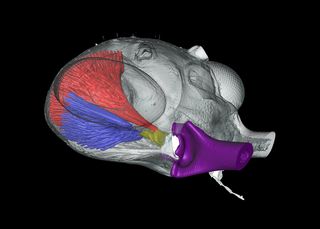Blink and You'll Miss It: Trap-Jaw Ant's Strike Is Swift, Deadly, Unique
Recently, researchers uncovered the adaptations that enable this superfast snapping in an elusive and little-studied genus of trap-jaw ants called Myrmoteras, using X-ray scans and high-speed video to analyze the ants' jaws in action — inside and out.
The scientists identified the latch, spring and trigger mechanisms for two Myrmoteras species, finding that their trap-jaw system operates in a manner unlike those in other groups of trap-jaw ants. [In Photos: Trap-Jaw Ant Babies Grow Up]
Myrmoteras ants are native to Southeast Asia and measure about 0.16 to 0.20 inches (4 to 5 millimeters) in length. They live and forage in leaf litter on the forest floor, which makes them difficult to find and capture while still alive, said study lead author Frederick Larabee, a postdoctoral research fellow with the Smithsonian AntLab at the Smithsonian National Museum of Natural History. It was previously unknown how fast the ants' jaws could snap closed and how exactly they worked, Larabee told Live Science.
When Myrmoteras' jaws are locked in the "open" position, as they are when the ant is hunting, they extend backward at a steep angle, pointing toward the ant's body. The Myrmoteras' ants' spiny, prey-catching mandibles are longer and more slender than those of their trap-jaw cousins, which suggests that Myrmoteras use these body parts to quickly stab and immobilize prey, rather than stunning them with a blow, the study authors wrote.

The scientists worked in the lab with several live colonies that had been previously collected, Larabee said. Footage shot at 50,000 frames per second revealed that the ants' jaws closed in about half a millisecond — not as quickly as ants in the trap-jaw genus Odontomachus, which snap their mandibles in one-tenth of a millisecond, according to the study.
But it was micro-CT scans — computed X-ray tomography — that enabled the researchers to detect and digitally model the inner workings of Myrmoteras' deadly strikes in 3D, the researchers said.
"We wanted to be able to visualize all the internal structures — the muscles, the neurons, and the attachments between the muscles and the mandible itself," Larabee said.
Sign up for the Live Science daily newsletter now
Get the world’s most fascinating discoveries delivered straight to your inbox.
Spring-loaded systems such as those found in trap-jaw ants have three main parts: a lock to hold the jaws open, a spring to store energy and a trigger to release the strike, transferring energy into the jaw to propel it closed at high speeds. Using CT scans, the researchers modeled the muscles responsible for opening and closing the jaws. Once the scientists knew what the muscles looked like, they could identify how they powered Myrmoteras' speedy bite, a process the researchers visualized in a video posted to YouTube.
The latch holding the jaws open was unlike any observed in other trap-jaw ants, resembling the locking mechanism in grasshopper legs, Larabee told Live Science.
Another unusual and unique structure that drew the scientists' attention was a strangely shaped lobe on the back of Myrmoteras ants' heads. The researchers noticed that it would compress immediately prior to a strike, hinting that the structure was part of the spring mechanism that released stored energy into the jaws.
"We're not entirely sure what the spring is, but we think it's the ligaments linking the muscle to the mandible," Larabee explained.

A spring-loaded jaw is a highly specialized feature, which makes it even more incredible that different ant lineages evolved such diverse structures to make these jaws work, Larabee said.
"All these ultrafast jaws, using different components or different body structures to serve this system — it's a great example of convergent evolution, where evolution has found different strategies for achieving the same behavioral goal," he said.
The findings were published online Aug. 30 in the Journal of Experimental Biology.
Original article on Live Science.

Mindy Weisberger is an editor at Scholastic and a former Live Science channel editor and senior writer. She has reported on general science, covering climate change, paleontology, biology, and space. Mindy studied film at Columbia University; prior to Live Science she produced, wrote and directed media for the American Museum of Natural History in New York City. Her videos about dinosaurs, astrophysics, biodiversity and evolution appear in museums and science centers worldwide, earning awards such as the CINE Golden Eagle and the Communicator Award of Excellence. Her writing has also appeared in Scientific American, The Washington Post and How It Works Magazine.

